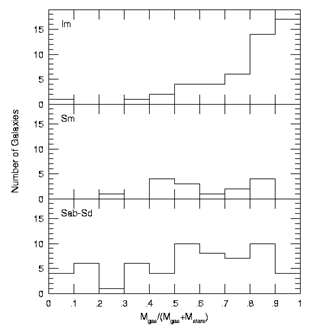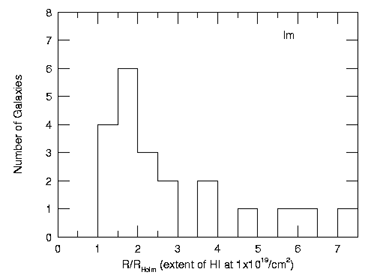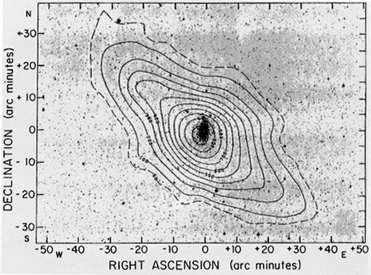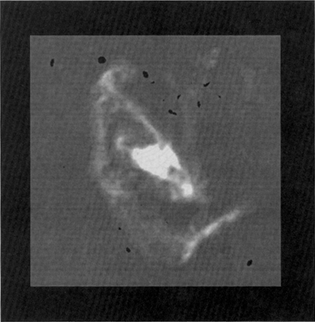


Irregular galaxies are very gas-rich systems as a class. Figure 12 shows the gas fraction, where the mass in stars has been very roughly estimated from integrated colors and star formation models (Larson & Tinsley 1978). Irregular galaxies generally have a high fraction of their observable mass in gas (see also Staveley-Smith et al. 1992). Like most disk galaxies, irregulars also usually have neutral hydrogen gas that extends beyond the ``edges'' of the optical galaxy itself (Huchtmeier et al. 1981; Carignan et al. 1989, 1990; Allsopp 1978; Cottrell 1976; van Woerden et al. 1975; Hunter & Gallagher 1985c; Hoffman et al. 1993; Broeils & van Woerden 1994; van Zee et al. 1995). According to H I data obtained by Huchtmeier et al. (1981) and Carignan et al. (1989, 1990), H I gas in irregular galaxies typically extends to twice the Holmberg radius, RH, at a column density of 1019 atoms cm-2. This is shown graphically in Figure 13. The Holmberg radius, defined as the radius of the galaxy where the photographic surface brightness drops to 26.5 magnitudes/arcsec2, is a good measure of the extent of the bulk of the stars in the galaxy. Yet, the gas extends well past this, suggesting that star formation has not taken place in the gas extended beyond this. Studies of spiral galaxies also often show the H I gas to be somewhat extended (Briggs et al. 1980), typically to twice the optical galaxy, and as much as 20% of the total gas may lie beyond the stellar surface brightness of 25 magnitudes/arcsec2 (Rogstad & Shostak 1972).

Figure 12. Fraction of galactic mass in gas. The mass in gas is that in H I and He and that in stars is estimated roughly from integrated colors and evolutionary models of Larson & Tinsley (1978). |
Among irregular galaxies with extended H I, there exist some with unusually extended gas distributions. For example, among the 21 irregulars whose sizes at 1019 atoms cm-2 is known from Huchtmeier et al. (1981) and Carignan et al. (1989, 1990), 6 have gas extending 4-7 times RH. In the case of one galaxy, IC10, 60% of the total H I content of the galaxy resides beyond RH (Huchtmeier 1979). Furthermore, the presence of unusually extended H I is not indicated by the optical properties of the galaxy (Huchtmeier et al. 1981).

Figure 13. Extents of H I at column densities of 1019 atoms cm-2 relative to the optically defined Holmberg radius RH of the galaxy. Data are from Huchtmeier et al. (1981), Carignan & Beulieu (1989), and Carignan et al. (1990). |
So, just what is the nature of this extended and unusually extended gas in irregular galaxies? The image of this gas that I have carried around with me for a long time is illustrated nicely by the single-dish map of the gas around NGC 6822 made by Roberts (1972) and reproduced in Figure 14. That is, the optical galaxy sits as the core of an extended gas envelope that is relatively smooth and quiescent. The reason that the extended gas has not formed stars is simply because the gas density is too low for the gas to be unstable out there.

Figure 14. Single-dish map of the extended H I envelope around NGC 6822 made by Roberts (1972). Reproduced with permission from Roberts and from the International Astronomical Union. |
However, this standard picture turns out not to be universally true among irregular galaxies. Hunter, Wilcots, van Woerden, & Gallagher (unpublished) have recently mapped the extended gas around NGC 4449 at 1' resolution and discovered remarkable large-scale structure in the H I gas, and this is shown in Figure 15. Optically, NGC 4449 is a fairly normal irregular galaxy. Although it lies at the more luminous and actively star-forming end of the distribution of ordinary irregular galaxies. NGC 4449 is otherwise not outstanding and has often been taken as representative of the more actively star-forming irregulars. Van Woerden et al. (1975) first mapped the large-scale H I distribution around NGC 4449 using the single-dish telescope at Effelsberg where the beamwidth is 9'. They found an elongated, symmetric distribution covering 1° x 0.7° on the sky. NGC 4449 is more extreme than the typical irregular galaxy in having neutral hydrogen gas extending to six times RH at 1019 atoms cm-2, a distribution that is about three times more extended than most other irregular galaxies (Huchtmeier et al. 1981). Bajaja et al. (1994) reobserved the galaxy with the Effelsberg telescope and determined that the outer gas distribution has an S-shape which they interpreted as the signature of a warp. Both groups found opposite velocity gradients between the central and outer gas. Thus, peculiarities in the distribution and kinematics of the gas had been hinted at.

Figure 15. VLA D-array mosaic map of the unusually extended H I around NGC 4449; the gas extends to 6 times the Holmberg radius and shows extraordinary structure. The field of view is 67'. Preliminary integrated H I map from Hunter, Wilcots, van Woerden, & Gallagher (unpublished). |
However, at the higher resolution the extended gas around NGC 4449 turned out to be spectacularly complex. The gas is resolved into enormous filamentary H I structures and clouds and is shown in Figure 15. A long streamer of gas emanates from the southern end of the central condensation, extends 37 kpc to the southwest, curves abruptly north for about 80 kpc, and then curves to the southeast for another 37 kpc, wrapping 3/4 of the way around the galaxy in the process. Another weaker streamer emanates from the northern part of the central H I condensation and extends south and then southeast about 53 kpc. NGC 4449 is not known to be interacting, although there is a smaller irregular galaxy, DDO 125, lying nearby at a projected separation of 40 kpc. However, the morphology of the extended gas suggests a highly disturbed or unsettled galaxy. Yet, in contrast to the morphology, not only is this gas cold (velocity dispersions of 5-10 km s-1) but it is also in regular rotation about the center of the galaxy.
As extraordinary as the structure in the extended gas of NGC 4449 is, however, NGC 4449 is not alone in providing surprises. Shostak & Skillman (1989) and Wilcots (1997) have mapped the extended gas around the irregular galaxy IC10. The gas associated with this galaxy extends to 7 RH and is the most extreme among the irregulars known. They have shown that the extended gas around this galaxy is also amazingly complex. Single-dish observations of IC10 had suggested that the outer envelope was turbulent and that there were different velocity gradients at small and large scales (Cohen 1979, Huchtmeier 1979), but the new VLA mosaic shows that the extended H I is concentrated in three arm-like structures and that IC10 is merging with a large infalling cloud to the south of the disk.
In summary then, most irregular galaxies have gas extended to about twice the optical Holmberg radius, as is the case with many spirals as well. However, there is a subset of irregulars with unsually extended gas envelopes. The extended gas associated with two of these galaxies shows extraordinarily complex structure, which could be signs of external perturbations or leftover debris from the process of galaxy formation. How long this gas will endure in these states is not clear. In most cases the extended gas is not a direct participant in the optical galaxy, but it could act as a slow reservoir replenishing the center as gas there is locked up in star formation (see also Larson 1991).